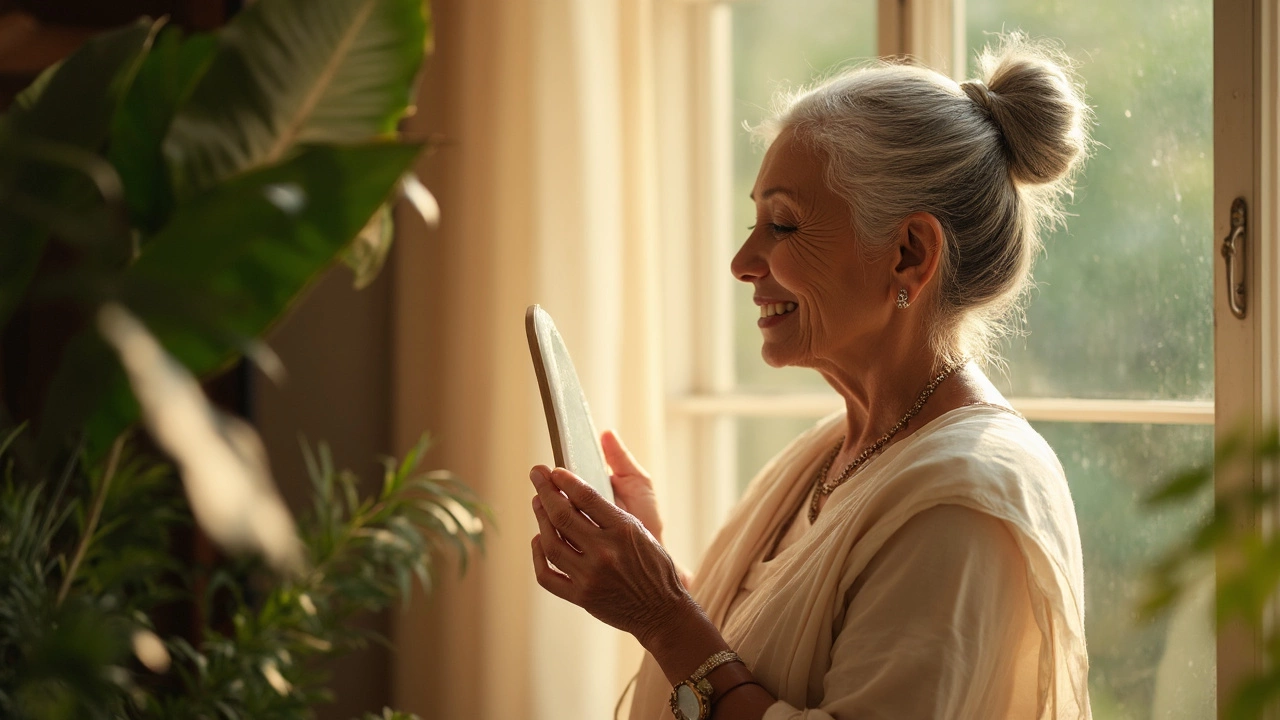
Age makes itself obvious on our faces first—deep wrinkles, lots of dryness, maybe some age spots or sagging. If you’re 70 or older, you’re probably seeing changes you never had to worry about before. Creams and cleansers you trusted for decades just don’t cut it anymore. Suddenly, you’re wondering what actually works—without wasting money on promises in fancy jars.
The good news: tons of skin science has exploded in just the last few years. There’s a real difference between what helps and what just clogs up your bathroom shelf. Forget twenty-step routines or magical quick fixes. The right moves at this age keep your skin comfortable, protected, and looking the best it can—no matter what you’re starting with.
- What Changes at 70?
- Ingredients That Actually Help
- Simple Routines for Real Results
- Modern Professional Treatments
- Habits That Protect and Support Your Skin
What Changes at 70?
Turning 70 is a wake-up call for your skin. It’s not just about more wrinkles showing up. Everything is slower—your skin doesn’t bounce back or heal like before. At this age, your body makes way less collagen than it did in your forties and fifties, which means skin starts sagging and those lines stick around.
Another big thing: natural oil production drops. That’s why so many women (and men) feel way drier or even itchy all the time. It’s not in your head. If you used to be oily or normal, dryness can sneak up and get annoying fast.
And it’s not just looks. The skin barrier—basically your natural shield—thins out, so you’re more likely to get irritated by weather, soaps, or even mild products. Age spots and uneven tone pop up now too, mostly from decades of sun exposure. Even wounds or little scratches take longer to heal.
| Skin Change | What Really Happens |
|---|---|
| Wrinkles | Loss of collagen & elastin, less "bounce back" |
| Dryness | Oil glands slow down, skin feels rough or tight |
| Sensitivity | Barrier thins out, easy to irritate or break |
| Age Spots | Sun damage shows up after years |
| Slow Healing | Cell turnover drops, scratches linger |
So if you’re frustrated that your old favorite products aren’t working, you’re not alone. The best treatment for 70 year old skin on face means understanding these changes. Staying flexible and open to what your skin needs right now makes all the difference.
Ingredients That Actually Help
With so many products lined up on store shelves, it can be tough to know what actually works for skin after 70. Not every label tells the truth. You want to focus on things that are proven, especially if your skin is thin, dry, or extra sensitive these days. Here’s what dermatologists recommend again and again for real, visible change.
- Retinol (Vitamin A): This ingredient has decades of study behind it. Retinol helps lessen wrinkles, fades spots, and smooths rough patches. Start with a low dose twice a week if you’re new to it because it can irritate skin that’s already delicate. Ask a doctor for prescription-strength retinoids if over-the-counter retinol isn’t cutting it.
- Vitamin C: Not just for orange juice. Vitamin C serums can brighten the skin, calm redness, and protect from more sun damage. Just make sure the product is stored in a dark bottle since Vitamin C breaks down in light.
- Hyaluronic Acid: Think of this like a tall glass of water for your face. It draws moisture right into your skin, making it look plumper and less lined. This is especially helpful if your skin feels tight or flaky all the time.
- Ceramides: Picture ceramides as the glue that keeps your skin barrier together. They help lock in moisture and defend against outside irritants. Look for them in creams or lotions, especially if you get itchy patches.
- Peptides: Peptides are little protein bits that signal your skin to make more collagen. More collagen means firmer skin that sags less.
- SPF: Never skip sun protection, even indoors near a sunny window. Daily SPF 30 or higher keeps new spots and wrinkles from popping up. Yes, it’s okay to use a gentle mineral sunscreen every single day.
Manufacturers love to pitch miracle-workers, but some things simply don’t have enough real proof behind them for this age group—save your money on trends like snail slime or caviar extracts.
| Ingredient | Proven Benefits | Best For |
|---|---|---|
| Retinol | Reduces wrinkles, fades dark spots, improves texture | Night creams & serums |
| Vitamin C | Brightens, helps sun damage, boosts collagen | Morning serums |
| Hyaluronic Acid | Hydrates, plumps, soothes dryness | Day & night moisturizers |
| Ceramides | Repairs skin barrier, locks in moisture | Creams & lotions |
| Peptides | Firms, supports collagen, aids repair | Serums, moisturizers |
| SPF (Sun Protection) | Prevents new spots/wrinkles | Daily sunscreen |
So, pick products that list these on their ingredient labels. Less is more—if the ingredient list is a mile long, it’s probably stuffed with fillers and perfumes your skin doesn’t want.

Simple Routines for Real Results
Less is definitely more when it comes to routines for aging skin. At 70, your skin is thinner, drier, and it takes longer to bounce back, so gentle and consistent care works best. Think practical over complicated—no one needs a ten-step process. The goal is to lock in moisture, keep things clean, and protect against further damage.
Here’s a straightforward routine that actually gives results:
- Gentle Cleansing: Use a non-foaming, fragrance-free cleanser. This will clean your face without stripping away the skin’s natural oils. Brands like CeraVe and Vanicream get the job done without irritation.
- Moisturizing: Pick a thick, barrier-boosting cream. Look for ceramides, glycerin, squalane, or hyaluronic acid on the label. These ingredients hold water in and stop skin from cracking or flaking.
- Sunscreen Year-Round: Protect from UV every single day—even in winter or while indoors, because window light still hurts aging skin. Dermatologists recommend a broad-spectrum SPF 30 or higher.
- Retinol or Retinoid (at night): This vitamin A ingredient is one of the few proven to smooth wrinkles and fade spots. Go slow—try it every third night and ramp up if your skin stays calm. Ask your dermatologist if prescription-strength is a good option for you.
- Don’t Over-Exfoliate: Exfoliating can actually make thin skin worse if you do it too often. Once or twice a week with a gentle AHA (like lactic acid) is enough for most people. Skip harsh scrubs and brushes.
Here’s a quick breakdown of what a day might look like:
| Time | Step |
|---|---|
| Morning | Cleanse (gentle), apply moisturizer, finish with sunscreen |
| Evening | Cleanse, apply retinol/retinoid if tolerated, moisturizer |
One thing I love about this routine? You can actually stick with it and see improvements within around 4-8 weeks. Most experts agree that for facial treatments for mature skin, these basics do most of the heavy lifting. If your skin’s happy and you’re comfortable, you’re on the right track.
Modern Professional Treatments
At 70, sometimes the stuff at home just isn’t enough. When you want a real jump in how your skin looks or feels, pros have legit tools and technology. Clinics and med spas aren’t about chasing miracles—they just have stronger methods than what you’ll find at the drugstore. Let’s look at what’s actually useful for aging faces right now.
Facial treatments like microneedling, chemical peels, and lasers are all tested on older skin. Microneedling can help with thickness and texture—basically, it pokes tiny holes in your skin, making it fire up its own repair process. Nothing scary, honestly. A study in the Journal of Clinical and Aesthetic Dermatology found people over 65 had less roughness and more glow after three sessions spaced a month apart.
Chemical peels have changed a lot in the past decade. Low-strength options target brown spots and “crepey” texture with much less redness now. Even people with sensitive skin usually tolerate these triple-acid blends if a dermatologist handles them. Lasers (like fractional or IPL) work on deeper wrinkles and can lighten stubborn sun spots; but you need a pro to decide if your skin is too thin or fragile for these. An honest skin consultation matters.
Feeling totally outnumbered by the wrinkle creams in your bathroom? Don’t worry. Most folks are surprised to learn professional treatments don’t always cost a fortune. Check out average pricing below. Some clinics even offer senior discounts or package deals for new clients.
| Treatment | What It Does | Usual Range (USD, per session) | Downtime |
|---|---|---|---|
| Microneedling | Improves texture & firmness | $200 - $400 | 0-2 days |
| Chemical Peel (mild) | Brightens, smooths out roughness | $150 - $300 | 0-3 days |
| IPL Laser | Reduces brown spots, redness | $250 - $500 | 1-5 days |
| Botox/Filler | Softens deep lines, restores volume | $300 - $800 | None to 1 day |
If you’re nervous, get a referral from your regular doctor or call local places and ask directly how often they treat people your age. Don’t let anyone talk you into more than you really want. Listen to this advice from dermatologist Dr. Amy Kassouf:
“Professional treatments work best when you’re realistic and do your research. The safest and most dramatic improvements come from clinics that ask a lot of questions and consider your whole health, not just your wrinkles.”
One last note: these treatments still need good skin habits at home. Sunscreen, gentle cleansing, and simple moisture keep your results longer. Combining pro care with daily basics? That’s how 70+ skin gets its best shot.

Habits That Protect and Support Your Skin
The simplest habits actually have the biggest impact on how skin ages—especially at 70. It’s not all about expensive products or fancy tools, either. It’s about what you do, day in and day out, to keep your face healthy and strong.
Your first line of defense? Sunscreen, every single day, even if you never set foot on a beach. Sun damage causes most of the wrinkles, spots, and roughness that show up as we get older. Doctors say look for a broad-spectrum SPF 30 or higher, and put it on like moisturizer: face, neck, ears, and even the tops of your hands. Make it a habit, just like brushing your teeth.
Moisturizing isn’t only for women in glossy magazine ads—it’s crucial for anyone with aging skin. Thicker, fragrance-free creams work best because older skin loses its natural oils. Apply right after washing your face to trap in moisture before it escapes. Bonus points for creams with ceramides or hyaluronic acid; those ingredients keep water in your skin, not just on top of it.
Gentle cleansing wins, too. Harsh soaps and scrubbing damage the skin’s barrier, making dry patches and irritation worse. Stick to lukewarm water and a mild, creamy cleanser. Pat your face dry—don’t rub it raw with a towel.
Here are some small tweaks that deliver real results:
- Switch out hot showers for warm ones—hot water dries out your skin way faster.
- Avoid long baths with bubbles or bath oils; they strip away protective oils.
- Use a humidifier in your bedroom during dry months to help your skin stay hydrated overnight.
- If you smoke, quitting is maybe the best gift you can give your skin at any age.
- Eat simple, basic real foods—veggies, fruits, fish, nuts, and good oils keep your skin cells fed from the inside.
The last piece is sleep. Your skin repairs itself while you snooze. Aim for good, regular sleep—your face actually needs it. Taking these habits seriously can back up every facial treatment you try and help your skin look and feel better for years to come.
 Hair Care
Hair Care